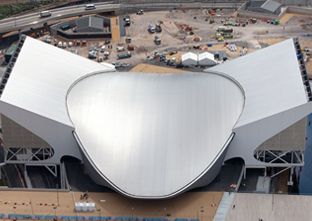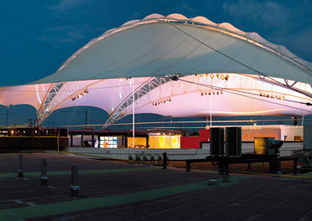From old circus tents to contemporary Olympic arenas

Your membranes have been a big hit for building the London Olympics’ temporary venues. Why is that ?
The choice of us as suppliers comes down to our know-how in manufacturing technical textiles for construction, our experience with leading designers of lightweight architecture and, especially, the original approach we have developed in this area. Technical performance and quality of materials are obviously key for bidding in major calls for tender. But at the end of the day, the fact that our industrial background dovetailed with the project's sustainable development requirements was what clinched it for us.

What in your approach might have grabbed London decision-makers’ interest ?

Mainly, the Olympic Delivery Authority’s concern to create "sustainable" facilities to standard environmental criteria like a low environmental footprint, using recycled and recyclable materials, but above all which wouldn’t end up as "white elephants" after the Olympics, i.e., oversized facilities that are costly to maintain and operate. This is where our textile architecture approach really wins out.
So in short, lightweight architecture is both sustainable and short-lived ?
 Sustainable, yes, but definitely not short-lived! Rather, textile architecture can be temporary in a given place for an event, because it is based on modular structures and building skins. But not always.
Sustainable, yes, but definitely not short-lived! Rather, textile architecture can be temporary in a given place for an event, because it is based on modular structures and building skins. But not always.
It’s temporary in the sense that it draws on an age-old tradition - the circus, to put it in simple terms, where the “big top” had to be mobile – i.e., dismantlable - but also last for decades just like traditional buildings. This is the ethos that we adapted to the new construction requirements.
What are the advantages of technical textiles ?
The first is being lightweight, which brings other advantages like using fewer raw materials, less energy for processing and so a smaller environmental footprint. Then there is the strength and durability of composite textiles made of a polyester core coated in high-performance PVC polymers.
That means that sustainable building skins can be designed. Some are fixed, like those of railway stations, shopping centres or media libraries. Others are more expansible or mobile because they are designed for modular structures like sporting and event venues.

What advantages do they have over traditional building skins ?
 These coverings are weatherproof and water-resistant, and so can last as long as those of traditional buildings, or even longer as they are often less costly to maintain and repair.
These coverings are weatherproof and water-resistant, and so can last as long as those of traditional buildings, or even longer as they are often less costly to maintain and repair.
They also allow free play for architectural creativity, such as in the management of natural light which is not just pleasing to the eye but also significant for indoor comfort, lighting and sunshine protection.
Isn’t using composite plastics bad from a recycling point of view ?

Composites are harder to recycle in theory, it’s true. But we’ve worked with the Solvay Group to develop a solution for recycling our end-of-life fabrics. This is the Texyloop recycling process that allows separating polyester fibre and PVC and integrates selection dissolving with complete solvent regeneration.
But our sustainable development approach means that this recycling, though essential, must only be the final stage of our product's lifespan. We firmly believe that the big plus point of our membranes is to have other alternative uses before that. First, because they are modular they can be reused for similar purposes; then they can be reused in other applications to make luggage, tarpaulins or sports mats ... So, the materials used to make our products have several lives within their life-cycle.
MORE INFORMATION
www.sergeferrari.com/sergeferrari/?langue=GB
contact.adhoc@free.fr





